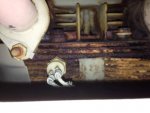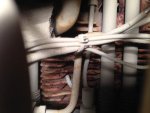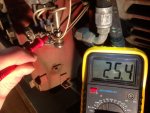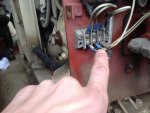Hello All,
Long time reader, first time poster. Last summer I researched generators for several months (losing power in sweltering July for 5 days will make you a bit neurotic about picking the right genset...), and finallydecided the MEP was what I needed. Many of the postings on thiswebsite led me to that decision - it has always been a trove of useful information. That year I bought a greatrefurbished 002A off of Storeman, which has served me faithfullysince that time (Thanks again, Storeman). Not long thereafter Idecided I wanted to get one off of auction and try my luck at it. Iwon a 002A a few months ago from govliquidation, which seemed to be agood bet. It had 158 hours on it (the hour meter at least seems to beauthentic), it still had batteries, oil, and diesel in the tank, andthe oil filter had a 10/12 date on it. Due to competing priorities athome, it wasn't until the last few weeks when I finally got aroundto going through the post-purchase maintenance procedures (flushingall fluids, changing filters, etc). One of the most satisfying sounds in the world I have heard wasthe diesel roaring to life the first time I cranked it. I gave it astress test with a 50 amp load for 2.5 hours (the gauge read 80-85%during that run) and she barely broke a sweat. Needless to say, I wasquite happy.
Now, all that being said, I did noticesomething during my physical inspection that worried me a bit. What Iassume are the cooling fins of the engine appear to be rusted. I tooktwo pictures – one from inside the pop-open cover above the oilfilter, and the other is taken through the flip-open grates justbeneath the exhaust tube. Should I be concerned about this? Is thereanything I should do to rectify the problem?


The other oddity I noticed was afterrunning it for several hours, the battery gauge needle was in theupper red portion of the gauge. I had never noticed my other unitdoing this, so I wasn't sure if it signaled a problem with the DCcharger? Or is that normal?
Thanks in advance for the advice.
Long time reader, first time poster. Last summer I researched generators for several months (losing power in sweltering July for 5 days will make you a bit neurotic about picking the right genset...), and finallydecided the MEP was what I needed. Many of the postings on thiswebsite led me to that decision - it has always been a trove of useful information. That year I bought a greatrefurbished 002A off of Storeman, which has served me faithfullysince that time (Thanks again, Storeman). Not long thereafter Idecided I wanted to get one off of auction and try my luck at it. Iwon a 002A a few months ago from govliquidation, which seemed to be agood bet. It had 158 hours on it (the hour meter at least seems to beauthentic), it still had batteries, oil, and diesel in the tank, andthe oil filter had a 10/12 date on it. Due to competing priorities athome, it wasn't until the last few weeks when I finally got aroundto going through the post-purchase maintenance procedures (flushingall fluids, changing filters, etc). One of the most satisfying sounds in the world I have heard wasthe diesel roaring to life the first time I cranked it. I gave it astress test with a 50 amp load for 2.5 hours (the gauge read 80-85%during that run) and she barely broke a sweat. Needless to say, I wasquite happy.
Now, all that being said, I did noticesomething during my physical inspection that worried me a bit. What Iassume are the cooling fins of the engine appear to be rusted. I tooktwo pictures – one from inside the pop-open cover above the oilfilter, and the other is taken through the flip-open grates justbeneath the exhaust tube. Should I be concerned about this? Is thereanything I should do to rectify the problem?


The other oddity I noticed was afterrunning it for several hours, the battery gauge needle was in theupper red portion of the gauge. I had never noticed my other unitdoing this, so I wasn't sure if it signaled a problem with the DCcharger? Or is that normal?
Thanks in advance for the advice.





